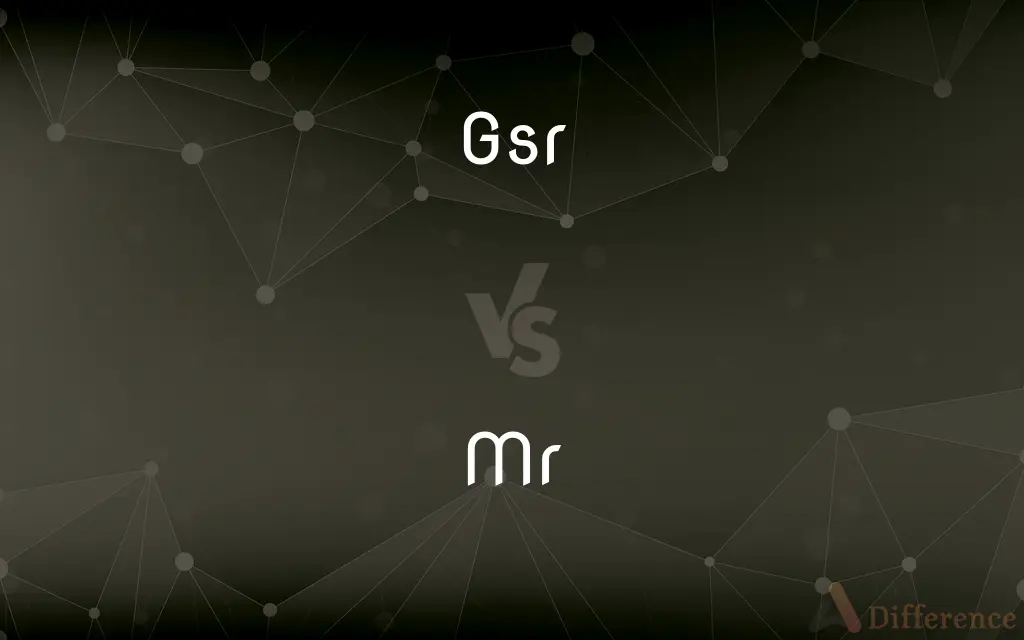GSR vs. MR — What's the Difference?
By Tayyaba Rehman & Urooj Arif — Updated on April 17, 2024
GSR (Galvanic Skin Response) measures skin conductance related to sweat and emotions, while MR (Magnetic Resonance) utilizes magnetic fields and radio waves to create detailed images of organs and tissues.

Difference Between GSR and MR
Table of Contents
ADVERTISEMENT
Key Differences
GSR, or Galvanic Skin Response, is a technique used primarily in psychophysiological research to measure changes in the electrical resistance of the skin, which vary with moisture levels due to sweat gland activity. This method is often employed in lie detection and stress analysis. On the other hand, MR, or Magnetic Resonance, includes techniques like MRI (Magnetic Resonance Imaging) and is used in medical settings to visualize detailed internal structures of the body, including soft tissues, which is crucial for diagnosing various medical conditions.
GSR is highly sensitive to emotional and physiological changes and is influenced by the autonomic nervous system, which responds to stress and stimuli without conscious control. This makes GSR a valuable tool in psychological studies and lie detection. In contrast, MR techniques focus on physical health, assessing conditions related to organs, muscles, and the brain, providing critical data for medical diagnosis and treatment planning.
The equipment and environments for GSR and MR significantly differ. GSR setups are relatively simple and portable, typically involving electrodes attached to the skin. Conversely, MR involves large, sophisticated machinery like MRI scanners, which require specially designed rooms to accommodate their magnetic fields and operational needs.
In terms of application, GSR is primarily used in research settings, such as psychological experiments, marketing studies, and usability testing, where physiological responses to various stimuli are analyzed. On the other hand, MR is predominantly used in clinical environments to assist in the diagnosis and monitoring of diseases such as cancer, neurological disorders, and musculoskeletal injuries.
The interpretation of data from GSR and MR also differs; GSR provides direct measurements of conductance that are relatively straightforward to interpret in terms of arousal levels. MR, however, often requires specialized software and expertise in radiology to interpret the complex images generated, which can provide a wide range of physiological information.
ADVERTISEMENT
Comparison Chart
Primary Use
Measuring physiological arousal and emotional response
Detailed imaging of internal body structures
Operational Principle
Electrical conductance changes in skin
Magnetic fields and radio waves
Main Applications
Psychophysiological research, lie detection
Medical diagnostics, particularly in imaging
Equipment Complexity
Low, with simple and portable devices
High, requiring large and complex machinery
Interpretation of Results
Relatively straightforward, reflects arousal levels
Requires expert analysis to interpret detailed images
Compare with Definitions
Gsr
A biofeedback method used in psychological studies to monitor emotional states.
In the study, participants' GSR levels increased when they were shown scary images.
Mr
A medical imaging technique that uses magnetic fields and radio waves to create detailed images.
The doctor ordered an MR scan to get a clearer picture of the spinal cord injury.
Gsr
A tool in lie detection based on skin conductivity changes.
The polygraph test included a GSR component to assess truthfulness.
Mr
Essential for assessing conditions in soft tissues, including the brain, muscles, and heart.
MR scans are critical for early detection of degenerative brain diseases.
Gsr
Indicates autonomic nervous system activity by measuring sweat secretion.
His GSR readings showed a spike during the difficult questions of the interview.
Mr
Non-invasive and does not involve ionizing radiation, making it safer for frequent use.
MR procedures are preferred for pediatric patients due to their safety profile.
Gsr
Measurement of the electrical resistance of the skin to assess sweat gland activity.
The therapist used GSR to determine the patient's stress levels during the session.
Mr
Utilized primarily in hospitals to diagnose and monitor internal physiological processes.
MR technology helped in diagnosing her brain tumor accurately.
Gsr
Used in user experience research to evaluate responses to products.
The company measured GSR of users to gauge reactions to a new app interface.
Mr
Involves the use of MRI equipment, which is large and requires a shielded environment.
The new hospital wing includes an advanced MR suite for enhanced imaging capabilities.
Gsr
A change in the electrical properties of the skin in response to stress or anxiety; can be measured either by recording the electrical resistance of the skin or by recording weak currents generated by the body
Mr
Mister. Used as a courtesy title before the surname or full name of a man. See Usage Note at Ms.
Mr
Used in informal titles for a man to indicate the epitomizing of an attribute or activity
Mr. Suave.
Mr. Baseball.
Mr
Abbreviation of millirem
Mr
A form of address for a man
Common Curiosities
What are the primary uses of MR imaging?
MR imaging is primarily used for detailed internal examinations of the body, crucial in diagnosing various medical conditions.
What does GSR measure?
GSR measures the electrical conductance of the skin, which changes with sweat gland activity.
What kind of equipment is used in GSR measurements?
GSR measurements are taken using small, portable devices with electrodes that attach to the skin.
Are there any risks associated with GSR?
GSR is non-invasive and low-risk, primarily involving minor discomfort from the electrode attachments.
What does an MR scan typically show?
An MR scan shows detailed images of internal body structures, such as organs, blood vessels, and tissues.
Can GSR be used for medical diagnosis?
While GSR can indicate stress levels, it is not typically used for medical diagnosis but rather for psychological assessments and research.
How do GSR and MR differ in their data interpretation?
GSR data interpretation is straightforward, focusing on arousal levels, whereas MR requires complex analysis to interpret detailed anatomical and functional images.
Can MR be used in psychological research?
While MR is mainly used for medical diagnostics, certain types such as functional MRI (fMRI) are used in psychological research to study brain activity.
Is MR safe for all patients?
MR is considered safe for most patients, though it is contraindicated for those with certain types of metal implants or devices due to its strong magnetic fields.
How do the costs of GSR and MR compare?
GSR equipment and tests are generally less expensive compared to the high costs associated with MR imaging technology and its operation.
Share Your Discovery

Previous Comparison
Candy vs. Lolly
Next Comparison
Rugby vs. SoccerAuthor Spotlight
Written by
Tayyaba RehmanTayyaba Rehman is a distinguished writer, currently serving as a primary contributor to askdifference.com. As a researcher in semantics and etymology, Tayyaba's passion for the complexity of languages and their distinctions has found a perfect home on the platform. Tayyaba delves into the intricacies of language, distinguishing between commonly confused words and phrases, thereby providing clarity for readers worldwide.
Co-written by
Urooj ArifUrooj is a skilled content writer at Ask Difference, known for her exceptional ability to simplify complex topics into engaging and informative content. With a passion for research and a flair for clear, concise writing, she consistently delivers articles that resonate with our diverse audience.














































